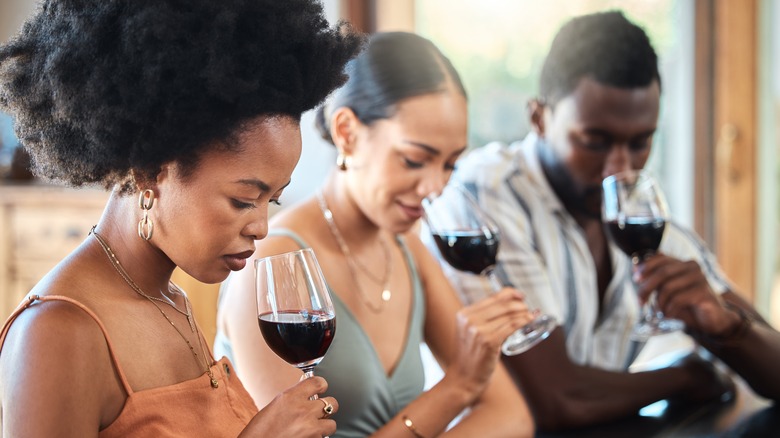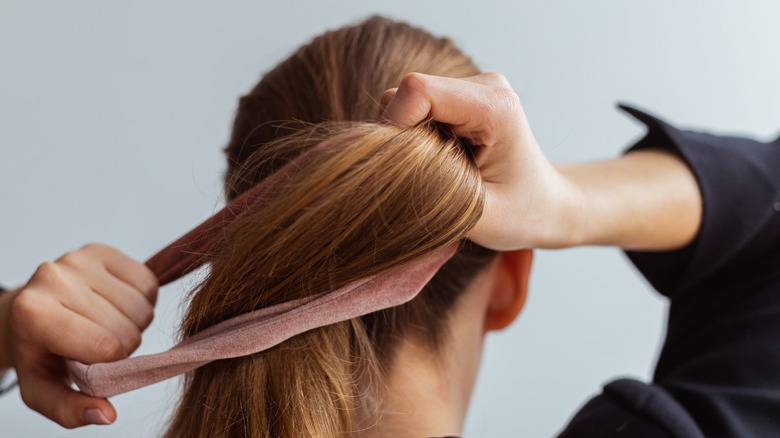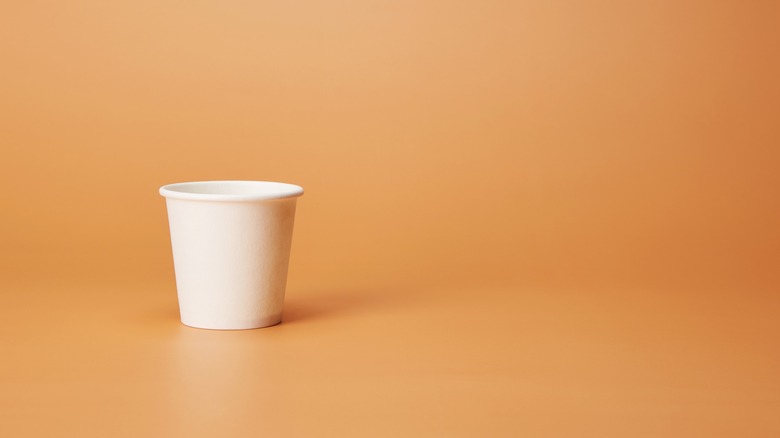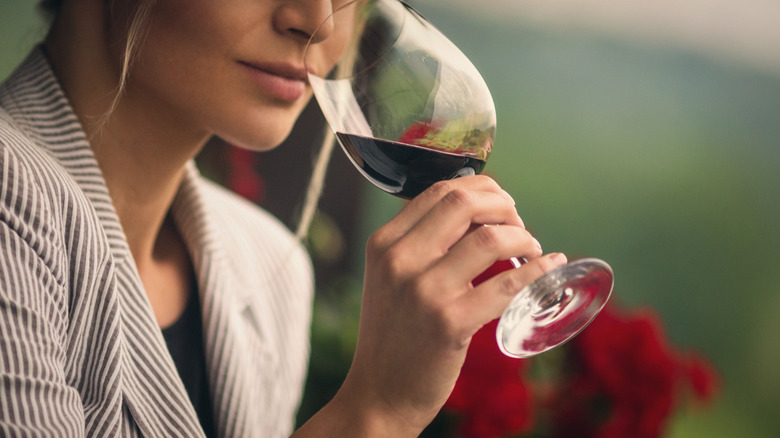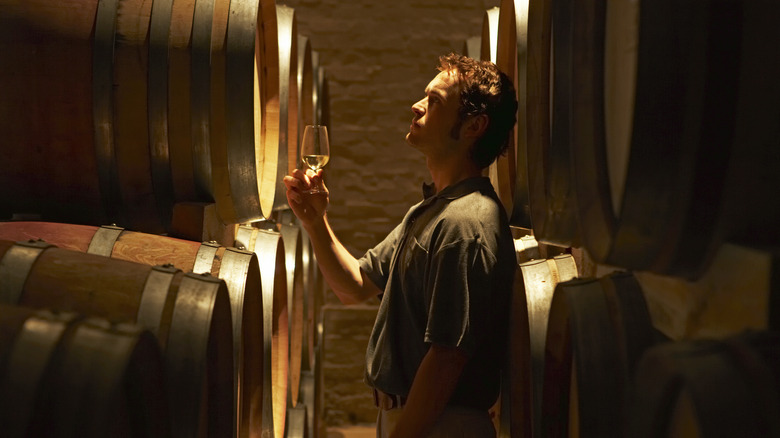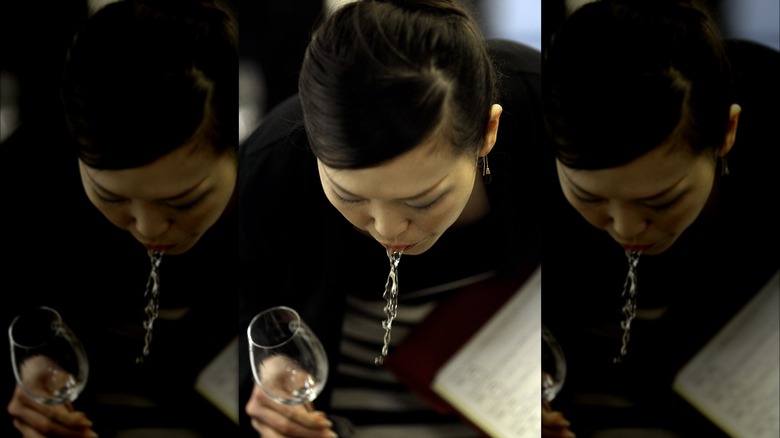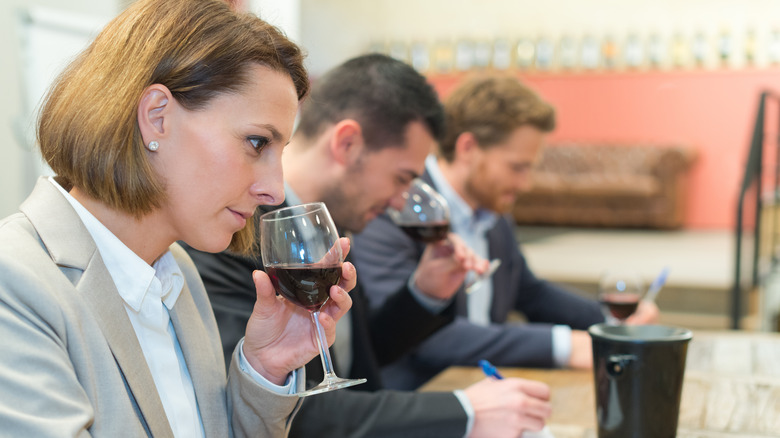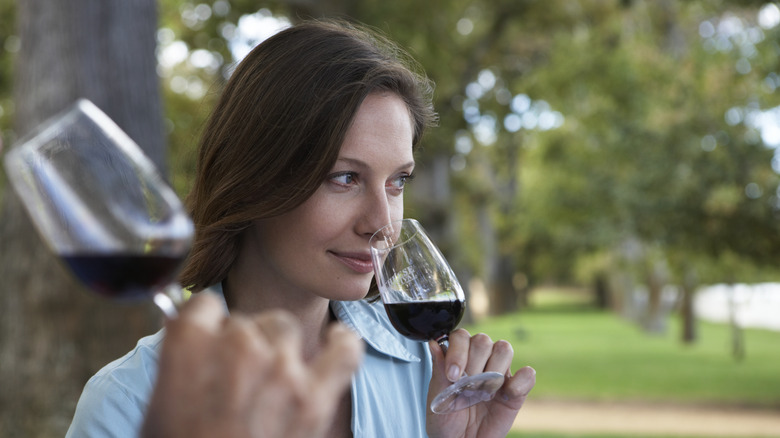Before Your Fancy Wine Tasting Visit, Master The Art Of Spitting
In the early days of my evolution as a culinary professional, I developed an interest in wine. I was fascinated by how it can enhance the dining experience, transforming an entire meal from mundane to magical. As I honed my skills as a chef, I educated myself on wine, eventually hosting wine-pairing dinners and offering dinner guests recommendations on which ones to pair with their meals.
My oenophilia took me on global treks from Napa to France to Morocco, where I visited many wineries. This education involved tasting a lot of wine. If you ingest all of it during a tasting, the alcohol will quickly catch up with you. This eventually dulls your senses, causing all the varietals you sample to lose their nuance. The solution — spitting wine.
This may sound like a nasty and unsanitary habit, but it's a necessary one. It will ensure you remain aware of your senses and may enhance the process. Master sommeliers and oenologists agree that some of the aromas in wine cannot be detected until after the wine has been swirled around in your mouth and spit out, an experience known as retro-olfaction.
If you have planned a fancy wine tasting during your next vacation and want to get the most out of it without feeling foolish, you should master the art of spitting. While it may take time, it will guarantee a much more pleasurable experience. The following are some indispensable tips for perfecting your expectorating skills.
Dress appropriately
Wearing inappropriate clothing is among the faux pas you do not want to make during a wine tasting. While fashion may not be the first thing that comes to mind in planning your wine tasting, what you wear can directly impact your ability to spit wine effectively, comfortably, and mess-free. Though wine tastings seem fancy, you do not need to be fussy. Dressing comfortably is crucial. That said, don't be a slouch. Wineries range in degree of elegance, but all command some respect, so this may not be the appropriate time to don those cute pajama pants and that well-worn sweatshirt.
If you are concerned about the temperature, dress in layers that can be easily added or removed. You will want to be mindful of loose, flowy clothing that can inadvertently hang into a spittoon or make holding a glass uncomfortable. Avoid clothes that are white or pale in hue. Regardless of how proficient you become at spitting wine, an occasional dribble or spill may occur. You will also want to keep jewelry to a minimum. This is not the time to wear the cumbrous, dangling earrings, bracelets, or necklaces, nor the opportunity to show off that fancy Birkin clutch. A small backpack or crossbody bag that holds the bare necessities without cluttering the wine bar is ideal.
Fasten long hair away from your face
Personal hygiene in its many forms is also a consideration at a wine tasting. If you have long hair, save time and effort by skipping the blowout and excessive grooming, and secure your locks into a nice ponytail or bun. This will ensure your coif doesn't end up in your glass or, worse, in the spittoon. This extends to those with facial hair. You may want to trim that mustache and beard just a bit to help keep it from impeding the experience.
This is also the time to refrain from applying that super hydrating lip puckering gloss that will leave a smudge on your wine glass. Opt for a simple, smudge-free, long-lasting lipstick that will stay put. Lastly, skip the strongly scented body sprays, deodorants, cologne, perfume, or hair care products. Anything that could potentially mask the aromas of the wine you are tasting will disrupt your, and others, ability to experience the process fully.
Bring your own cup
One topic that seems to bring up big feelings and opinions from wine professionals and amateur oenophiles alike is the spittoon. For the uninitiated, when attending a wine tasting, you will often be presented with a plastic or metal bucket-like container known as a spittoon. This communal vessel is where you are intended to dispose of your wine as you spit it out. While it makes logistical sense, there are some considerations to using the spittoon.
First, you may feel self-conscious about expectorating your wine into the communal spittoon while everyone watches. It may feel like you are being evaluated on some bizarre target practice involving an amorphous ballistic made from a liquid while using an unwieldy firearm. Then there is the issue of splashback and the possibility that you may end up with the spit of other people on your person or in your mouth.
If you are a germaphobe, like I am, or dislike the idea of being on display, you might consider bringing a cup to use for spitting. It is a closer, easier target to hit, and you don't have to share it with anyone. Any disposable cup will do. If you plan to visit multiple wineries, you might bring several cups to use and dispose of at each location. If you do not want to hassle with carrying a cup and are keen on the immersive experience, use the spittoon.
Take small sips
Wine tasting is what it sounds like. You are being offered a small sampling of multiple wines rather than a full glass. The average tasting includes a 2-ounce pour of each wine, with some even smaller depending upon how many wines are included in the sampling. For reference, a bottle of wine will yield roughly 12 servings for a tasting.
Once your wine is poured, swirl the glass before you take a sip. Doing so helps to infuse the wine with oxygen, allowing it to open up and release its flavors. It also helps amplify the initial aromas of the wine, giving you a base point to compare it to when you eventually spit it out. After swirling, give the wine a sniff and take a small sip. This is not the time to chug the whole serving at once. The more you have in your mouth, the harder it will be to meaningfully assess the flavors and spit the wine out without making a huge mess.
Swish the wine around in your mouth
Once you get that sip in your mouth, you will want to swish it around in your mouth. This helps to distribute the flavors to all your taste buds so that you can more adequately assess every element within the wine, including sweet, salty, sour, bitter, and umami.
Contrary to what we may have been taught in elementary school by way of the simplistic tongue map, how we detect the various tastes on our tongue is not isolated to specific regions of this organ. Taste receptors are sporadically distributed across all parts of the tongue, soft palate, and throat. The precise location and capacity to detect certain flavors varies from person to person.
For this reason, allowing that sip of wine to coat every corner of your mouth and throat will give your taste receptors a chance to do their job. This will enable you to discern what you are tasting more meticulously, detecting specific notes of fruit, oak, spices, petrol, and more.
Aim with intention
Now that you have swirled, sipped, and swished your wine, it is time to spit it out into your cup or the spittoon. The first step is to draw your chin backward so your head is tilted forward. Not doing so will result in the wine dribbling straight down your chin and onto your shirt. Additionally, lean forward so that any overflow ends up on the floor rather than on you.
While it may sound gross, the ideal posture for spitting wine is not too dissimilar to the one you would adopt if you feel nauseated. Many can relate to not wanting to get messy and aiming for a trash bin; it is practically instinctual. Let those instincts translate to your wine-tasting experience. When you are ready to spit the wine out, bring the spittoon or cup closer to your face and tilt it toward you before you let it rip.
Use a slow and steady stream
All this talk about spitting may confuse some when executing the process. The word spit is somewhat of a misnomer. You are expelling your wine in a slow, steady stream reminiscent of a small yet powerful human fountain. If the image of a statue in a fountain dating back to the Italian Renaissance with a man or woman spewing water from their mouths is coming to mind, you are getting the right idea.
Begin by moving the wine toward the front of your mouth. Without using too much force or engaging your teeth as a projectile launching device, gently purse your mouth and blow just enough to eject the wine into the cup or spittoon in a delicate stream. If a stream feels unattainable, a gentle waterfall will suffice. Regardless of how the flow appears, this is not a contest to see who can spit the farthest so much as an exercise in restraint.
Let gravity be your friend
If all of this feels overwhelming, it need not be as complicated as it sounds. No matter how hard we attempt to defy it, gravity always has a way of working. This is no less true than in the process of spitting wine.
If you open your mouth, gravity will take care of the rest. Let this work to your advantage. Once adopting the appropriate stance and getting the wine to the front of your mouth with the spittoon or cup expertly positioned, allow gravity to take over. The wine will inevitably land in the collecting vessel, and you will feel triumphant.
If you dribble a little, it's not a big deal. Even experts who have done this a million times have had their mishaps and continue to have the occasional rogue splash of wine. Just be sure to ask for a napkin at the beginning of the tasting and keep it on hand to dab your mouth and chin as necessary. This is particularly sound advice if you have facial hair, which can present unique challenges.
Cleanse your palate between sips
One of the most valuable tips for novice wine tasters to master between sips is the value of cleansing your palate. Even if you are not drinking your wine and properly spit between samples, you will need to have a chance to give your taste buds a reset to factory settings. This will ensure you get the most out of your tasting and detect the nuances between each varietal you sample. This is best accomplished by eating or drinking something bland.
Some of the best edible treats include bread, a subtle cheese, fruit, celery, green olives, or plain crackers. Where beverages are concerned, fizzy drinks tend to be the most effective at re-calibrating your taste buds. I prefer unflavored sparkling water and a simple charcuterie board with all the classics.
While cleansing your taste buds, do not forget to attend to your olfactory senses. Your nose can benefit just as greatly from a reboot to help it better discern the plethora of aromas wafting from each wine. A valuable tool for this purpose is to have whole coffee beans handy; one whiff will have your sniffer feeling like it is brand new.
Practice at home
One technique to use when preparing for your fancy wine-tasting visit is to start practicing at home. They say practice makes perfect. While you may never get wine spitting perfect, you can get more comfortable with the process, which will make you feel infinitely less self-conscious, help you have more fun, and enhance your capacity to enjoy the wine. That is a win all around.
A good rule of thumb is to practice the technique in the shower and pretend to spit into the spittoon. It is just water, so it'll instantly wash away if you make a mess, and nobody will be there to witness it. Once you feel a bit more empowered, graduate to the sink. You have to brush your teeth twice a day anyway so you might as well turn this into a practice wine-spitting session with your mouthwash.
As you master the technique, invite some trusted friends for a mock tasting with a couple of bottles of inexpensive wine. Throw together some of your favorite appetizers and have some fun. Engaging in this activity with those whose company you enjoy and feel safe around can make it less intimidating to make a fool of yourself if you have a disaster. Who cares? It's all about fun.
Don't be afraid
If there is one big takeaway from this list of tips I want you to remember the most, it is not to be afraid. Wine tasting seems sophisticated, but it need not be. In today's world, good quality wine is more accessible than ever and less expensive. Wine drinking is no longer for the elite. Anyone can enjoy it with basic knowledge without breaking the bank or needing a fancy sommelier certification.
And wine tastings are available everywhere, from vineyards with tasting rooms surrounded by panoramic views to restaurants to your local Costco. These are generally informal events intended to bring people together, teach them a thing or two about wine, sell some bottles, and have fun. Take this opportunity to learn about sipping wine as a chance to learn a new skill that you can use to help you expand your horizons. There will not be a grade for how well you spit, nor will you be penalized if you accidentally get some wine on the bar, the floor, or down your shirt.
Reserve your drinking for the end
Depending upon the tasting and how many you plan to enjoy in one day, I recommend keeping good notes on the wines you like the most. Tasting rooms, restaurants, or stores often give you a notepad or a chart to help you document your experience so you can go back and purchase your favorites.
By spitting, you will not get as intoxicated, affording you the luxury of relaxing at the very end of the day of drinking with a glass of your favorite wine or two that you sampled. And I promise you that the experience will be that much more enjoyable. You will have gained valuable knowledge along your wine-tasting journey, from the terroir and the kinds of grapes to what aromas to look for to how much acidity or tannins to expect. This will give you a newfound appreciation for that wine, making it worth every swish and spit.
